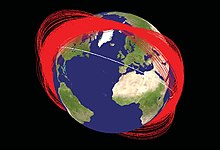Fengyun-1C
| Fengyun-1C | |
|---|---|
| Type: | Weather satellite |
| Country: |
|
| COSPAR-ID : | 1999-025A |
| Mission dates | |
| Begin: | May 10, 1999, 1:33 UTC |
| Starting place: | Taiyuan |
| Launcher: | CZ-4B |
| Status: | destroyed on January 11, 2007 |
| Orbit data | |
| Rotation time : | 102 min |
| Orbit inclination : | 98.6 ° |
| Apogee height : | 868 km |
| Perigee height : | 849 km |
Fengyun-1C ( FY-1C ; Chinese wind and clouds) was a Chinese weather satellite of the Fengyun series, which was launched on May 10, 1999 in an approximately 849 to 868 km high polar orbit ( orbit inclination 98.6 °). Its sensational destruction on January 11, 2007 by a ground-based medium-range missile brought the disused satellite into the headlines worldwide. It was the first direct launch of a spacecraft from the surface of the earth.
details
The anti-satellite missile was launched from the Chinese spaceport Xichang and collided with the target object, which was completely destroyed. Fengyun-1C broke into over 40,000 pieces of debris with a diameter of over one centimeter and many millions of smaller pieces, according to US experts. These were hurled on many different tracks - including those that reached great heights. The danger that such space debris always poses for other space companies is therefore worrying .
The shooting triggered fears around the world. The downing of the satellite was "the largest military demonstration of power by China in a long time and shows that the coming world power is intensely concerned with one of the potentially greatest security problems of the future - the militarization of space," judged the Frankfurter Allgemeine Zeitung , for example . Numerous expert observers speculated that the downing would make a new arms race in space almost inevitable.
According to calculations by the SOCRATES program, a fragment ( NORAD 30670) most likely collided with the small satellite BLITS (NORAD 35871) on January 22, 2013 at 03:08 UTC. The resulting largest fragment is listed under Norad catalog number 39119.
In February 2008, the USA 193 satellite, which had got out of control, was shot down by the USA in order to prevent any danger to people and the environment from the fuel on board. In contrast to the Chinese weather satellite, the ruins of USA 193 no longer pose a threat to other space travel ventures, as all debris burned up 231 days after the destruction.
Quotes
“[The] purpose of a shock-and-awe strike in space is to deter the enemy, not to challenge the enemy to battle. For this reason, the targets for such a strike must be few and precisely selected [...] [for example] on important information sources, command & control facilities, communication hubs and other targets. This will shake the structure of the operational organization system of the opponent and produce a huge psychological effect on the political leaders of the opponent. "
“The new arms race in space is developing into the largest industrial project in the history of the earth. […] But there is a problem: if the United States can do all of this, another nation could too. […] During the terms of both Clinton and the second Bush , Russia and China submitted a resolution to the United Nations General Assembly calling for a new treaty banning space weapons. The Prevention of an Arms Race in Space ( PAROS ; for example: preventing an arms race in space) would outlaw all weapons in and through space and close the stable door before the horse can get out. Unfortunately, the United States' stance has been consistent throughout both Democratic and Republican governments: there are no weapons in space and therefore no need for a new treaty. The United States claims there is no problem. "
Web links
- Dirk Lorenzen : Space: Star Wars. on: time online. February 21, 2008.
- Weapons technology: Chinese plan space war. on: Spiegel online. October 20, 2003.
See also
swell
- ↑ China's Asat Test Will Intensify US-Chinese Faceoff in Space. In: Aviation Week & Space Technology. January 21, 2007, accessed April 25, 2009.
- ↑ Uwe Reichert: Environmental disaster in orbit. In: Stars and Space . 46 No. 4 (April 2007), ISSN 0039-1263 , p. 24.
- ↑ Anti-satellite test generates dangerous space debris. ( Memento of January 21, 2007 in the Internet Archive ) In: New Scientist. January 20, 2007, accessed April 25, 2009.
- ↑ Arms race in space? Vulnerable satellites. In: Frankfurter Allgemeine Zeitung. January 20, 2007, accessed April 25, 2009.
- ↑ Chinese space debris hits Russian satellite ( Memento from March 11, 2013 in the Internet Archive ) In: AGI Blog. March 8, 2013, accessed March 9, 2013.
- ↑ USA 193 - the last piece of rubble burned up. on: raumfahrer.net , October 21, 2008.
- ↑ Office of the Secretary of Defense: Annual Report to Congress: Military Power of the People's Republic of China 2008. US Department of Defense, 2007. (PDF; 29.6 MB)
